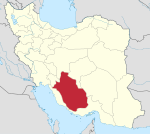Karyan, Fars
Karyan Persian: كاريان | |
|---|---|
Village | |
| Coordinates: 28°08′55″N 53°32′34″E / 28.14861°N 53.54278°E[1] | |
| Country | Iran |
| Province | Fars |
| County | Juyom |
| District | Harm |
| Rural District | Karyan |
| Population (2016)[2] | |
| • Total | 2,919 |
| Time zone | UTC+3:30 (IRST) |
Karyan (Persian: كاريان)[a] is a village in, and the capital of, Karyan Rural District of Harm District, Juyom County, Fars province, Iran.[4]
At the 2006 National Census, its population was 2,068 in 404 households, when it was in Harm Rural District of the former Juyom District of Larestan County.[5] The following census in 2011 counted 2,843 people in 730 households.[6] The latest census in 2016 showed a population of 2,919 people in 749 households.[2]
After the census, the district was separated from the county in the establishment of Juyom County and divided into two districts of two rural districts each, with Juyom as its capital and only city.[4]
Karyan is the setting of a Zoroastrian legend during the time of the Muslim conquest of Persia, where a Muslim force of 12,000 men besieged Karyun only to be slain single-handedly and unopposed by a Persian defender named Shah Karan while they were engaged in their prayer.[7] However, a new Muslim army, seeking revenge, was able to conquer Karyan after the betrayal of Shah Karan's wife and the residents were then massacred.[8]
Notes[edit]
References[edit]
- ^ OpenStreetMap contributors (20 September 2023). "Karyan, Juyom County" (Map). OpenStreetMap. Retrieved 20 September 2023.
- ^ a b "Census of the Islamic Republic of Iran, 1395 (2016)". AMAR (in Persian). The Statistical Center of Iran. p. 07. Archived from the original (Excel) on 6 April 2022. Retrieved 19 December 2022.
- ^ Karyan can be found at GEOnet Names Server, at this link, by opening the Advanced Search box, entering "-3069759" in the "Unique Feature Id" form, and clicking on "Search Database".
- ^ a b Mokhbar, Mohammad (25 December 1400). "Letter of approval regarding the country divisions of Larestan County, Fars province". Qavanin (in Persian). Ministry of Interior, Council of Ministers. Archived from the original on 20 September 2023. Retrieved 20 September 2023.
- ^ "Census of the Islamic Republic of Iran, 1385 (2006)". AMAR (in Persian). The Statistical Center of Iran. p. 07. Archived from the original (Excel) on 20 September 2011. Retrieved 25 September 2022.
- ^ "Census of the Islamic Republic of Iran, 1390 (2011)". Syracuse University (in Persian). The Statistical Center of Iran. p. 07. Archived from the original (Excel) on 16 January 2023. Retrieved 19 December 2022.
- ^ Mary Boyce (1967). "Bībī Shahrbānū and the Lady of Pārs". Bulletin of the School of Oriental and African Studies, University of London. 30 (1, Fiftieth Anniversary Volume (1967)). Cambridge University Press on behalf of School of Oriental and African Studies: 41. doi:10.1017/s0041977x00099080. JSTOR 611813. S2CID 162849583.
In the Harm district of Fars, not so very far from Yazd, Edward Strack came across a naive legend which is a rough inversion of the Zoroastrian one; see his Six months in Persia, I, London, 1882, 119. According to this, at the time of the Arab invasions, a certain Zoroastrian, Shah Karan, was besieged at Karyun by 12,000 Arabs; and sallying out of the fort while they were at their prayers (which they would not leave), he slew them all. There were 40 virgins in the camp, who prayed to Allah for deliverance from him. The earth duly opened and swallowed 37 of them. The remaining three fled, pursued by him and his men. One turned to the mountains to the north and was nearly captured, when a cave opened in the mountain-side and she ran in and disappeared. 'The cave is called The Ghar Bibi, or Lady's Cave, to this day, and is well known to have no end.' Another of the maidens also disappeared into the mountain-side 'and water has trickled from the cleft ever since'. The third is said to have died of exhaustion on the mountains to the south. ' Her shrine, called that of the Bibi darmanda, or Tired-out Lady, is a famous place of prayer for childless wives.'
- ^ Edward Stack (2013) [Original work published 1882]. "Six Months in Persia". 1: 119–21. Archived from the original on 26 June 2014. Retrieved 24 June 2014.
{{cite journal}}: Cite journal requires|journal=(help)


 French
French Deutsch
Deutsch
